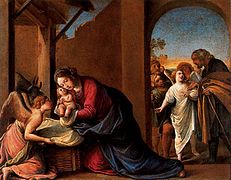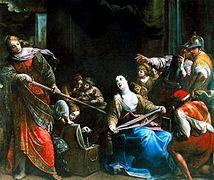Alessandro Tiarini
Alessandro Tiarini | |
|---|---|
 Self-Portrait, (Galleria Savelli, Bologna) | |
| Born | 20 March 1577 |
| Died | 8 February 1668 (aged 90) |
| Nationality | Italian |
| Education | Prospero Fontana & Bart. Cesi |
| Known for | Painting |
| Movement | late-Renaissance and Baroque |
Alessandro Tiarini (20 March 1577 – 8 February 1668) was an Italian Baroque painter of the Bolognese School.

Biography
He was born in Bologna. His mother died when he was a child, and he was raised by an aunt, and early on they tried, unsuccessfully to guide him towards becoming a cleric.[1] He was the godson of painter Lavinia Fontana and initially apprenticed in Bologna under her father Prospero Fontana, and subsequently with Bartolomeo Cesi. He was not inducted into the Carracci Academy. Forced to flee from Bologna, due to what Malvasia and Amorini describe as a quarrel leading to the death of the other party, he moved to Florence, where he painted frescoes, façade decorations, and altarpieces (1599–1606) including an Adoration of the Shepherds (Pitti Palace). In Florence, he mainly worked under Domenico Passignano, but also Bernardino Poccetti and Jacopo da Empoli.
He was lured back to Bologna and Reggio Emilia, by Ludovico Carracci. His Grieving over a dead Jesus is in the Pinacoteca Nazionale of Bologna. He painted a series of frescoes for the Brami Chapel in the sanctuary, as well as other works, for the Basilica della Ghiara in Reggio Emilia. He also painted in Cremona (1623–24). In 1628, where he painted the Story of Gerusalemme Liberata for the Farnese Palazzo del Giardino in Parma. He also painted the Raising of the Cross for the Oratorio della Buona Morte in Reggio, a work now displayed in the Galleria Estense of Modena.
He painted a Virgin, Mary Magdalene, and St John, weeping over the instruments of the Passion for church of S. Benedetto; St. Catherine kneeling before a Crucifix for Santa Maria Maddalena; a Pietà for Sant'Antonio; and St Dominic resurrecting a child for the church of San Domenico. Other works in Bologna include a Martyrdom of St. Barbara for the San Petronio Basilica, a Nativity for Santissimo Salvatore, and a Flight to Egypt for San Vitale.
Tiarini died in Bologna. His closest pupils were Francesco Carbone and Luca Barbieri.
References
- ^ Amorini p72
- Francis P. Smyth and John P. O'Neill (Editors in Chief) (1986). National Gallery of Art, Washington DC (ed.). The Age of Correggio and the Carracci: Emilian Painting of the 16th and 17th Centuries. pp. 538–542.
{{cite book}}:|author=has generic name (help) - Marchese Antonio Bolognini Amorini (1843). Vite de Pittori ed Artifici Bolognesi. Tipografia Governativa alla Volpe ed Nobili, Bologna. pp. 72–93.
- Bryan, Michael (1889). Walter Armstrong & Robert Edmund Graves (ed.). Dictionary of Painters and Engravers, Biographical and Critical (Volume II L-Z). York St. #4, Covent Garden, London; Original from Fogg Library, Digitized May 18, 2007: George Bell and Sons. p. 570.
{{cite book}}: CS1 maint: location (link)
Gallery
-
Coronation of Virgin (Basilica della Ghiara, Reggio Emilia)
-
Resurrection of Lazarus (Museum of Fine Arts, Yekaterinburg)
-
Nativity (Ufizzi, Florence)
-
Sack of Troy (Galleria Nazionale, Rome)
-
Historical Scene (Collegio di Propaganda Fide, Rome)
-
Achilles and the daughters of Licomedes (Galleria Nazionale, Rome)
-
Resurrection Miracle, (San Domenico, Bologna)
-
Assumption of the Virgin (San Domenico, Budrio)
-
Holy Family (Hermitage, St Petersburg)
-
Pieta (San Benedetto, Bologna)
-
Repentance of St Joseph (Louvre, Paris)
-
Virgin and child with Sts Scholastica & Benedict (Museo della Rocca, Dozza)
-
Three Monks contemplate Crucifix (Palazzo Rosso, Genoa)














